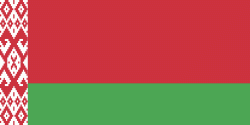Shchuchyn
Shchuchyn and Ščučyn (Шчучын, Ščučyn, ; Щýчин, ; Szczuczyn Litewski; Šukynas; Yiddish: שטשוטשין, Shtshutshin) is a city in the Grodno Region of Belarus. It is the center of Shchuchyn District. The population is nearly 15,000 (2010).
The first known official written mention of Shchuchyn is recorded in 1436, but its foundation as a settlement dates back to 1537, when 'Shchuchyn was mentioned in the Book of Acts of the Lithuanian Metrica (the Book of Lithuanian vital records), kept in the Governmental archive in Lithuania.
Ownership of Shchuchyn passed from one noble family to another: The Radziwiłł family, then the Drutskiya-Liubetskis, the Scipions, and others ruled Shchuchyn in turn. In the 15th–18th centuries, Shchuchyn became a member of the Lida council of the Vilnius office of voivode. In the first half of the 17th century, Shchuchyn was governed by the outsider marshal of the Lithuanian principality, Scipio de Campo. Shchuchyn was an average-sized privately owned village in terms of population.
A Catholic Monasterial Order was established 1726 in Shchuchyn by the resolution of the Sejm. The Board of Shchuchyn was considered to be one of the biggest in Belarus.
Shchuchyn was subject to ruin and ravage more than once in its history. The biggest was in the time of the North War, after the town was seized by the Swedish king Karl XII. After the third partition of the Polish–Lithuanian Commonwealth in 1795, Shchuchyn became a part of the Russian Empire. In June 1812 Shchuchyn was occupied by French troops. And again in 1915, by the German Kaiser. In 1919 the Red Army attempted to seize Belarusian land by taking and fortifying the Martinkantsy - Shchuchyn - Shchara - lake Vygonovskoe line. However, the superior defence forces of the "Land of Grodnenskaya", together with Poland, forced the Red Army back. In 1939, Western Belarus, together with Shchuchyn, went under the control of the Soviet authorities. In World War II, Shchuchyn was occupied by German troops.
During the Nazi occupation from 25 June 1941 until 13 July 1944 the Nazi forces killed about 2180 Jews from the Shchuchyn ghetto with the majority of them killed on 10(9) May 1942.
In 1962, Shchuchyn was granted town status.
The first known official written mention of Shchuchyn is recorded in 1436, but its foundation as a settlement dates back to 1537, when 'Shchuchyn was mentioned in the Book of Acts of the Lithuanian Metrica (the Book of Lithuanian vital records), kept in the Governmental archive in Lithuania.
Ownership of Shchuchyn passed from one noble family to another: The Radziwiłł family, then the Drutskiya-Liubetskis, the Scipions, and others ruled Shchuchyn in turn. In the 15th–18th centuries, Shchuchyn became a member of the Lida council of the Vilnius office of voivode. In the first half of the 17th century, Shchuchyn was governed by the outsider marshal of the Lithuanian principality, Scipio de Campo. Shchuchyn was an average-sized privately owned village in terms of population.
A Catholic Monasterial Order was established 1726 in Shchuchyn by the resolution of the Sejm. The Board of Shchuchyn was considered to be one of the biggest in Belarus.
Shchuchyn was subject to ruin and ravage more than once in its history. The biggest was in the time of the North War, after the town was seized by the Swedish king Karl XII. After the third partition of the Polish–Lithuanian Commonwealth in 1795, Shchuchyn became a part of the Russian Empire. In June 1812 Shchuchyn was occupied by French troops. And again in 1915, by the German Kaiser. In 1919 the Red Army attempted to seize Belarusian land by taking and fortifying the Martinkantsy - Shchuchyn - Shchara - lake Vygonovskoe line. However, the superior defence forces of the "Land of Grodnenskaya", together with Poland, forced the Red Army back. In 1939, Western Belarus, together with Shchuchyn, went under the control of the Soviet authorities. In World War II, Shchuchyn was occupied by German troops.
During the Nazi occupation from 25 June 1941 until 13 July 1944 the Nazi forces killed about 2180 Jews from the Shchuchyn ghetto with the majority of them killed on 10(9) May 1942.
In 1962, Shchuchyn was granted town status.
Map - Shchuchyn
Map
Country - Belarus
 |
 |
| Flag of Belarus | |
Until the 20th century, different states at various times controlled the lands of modern-day Belarus, including Kievan Rus', the Principality of Polotsk, the Grand Duchy of Lithuania, the Polish–Lithuanian Commonwealth, and the Russian Empire. In the aftermath of the Russian Revolution in 1917, different states arose competing for legitimacy amid the Civil War, ultimately ending in the rise of the Byelorussian SSR, which became a founding constituent republic of the Soviet Union in 1922. After the Polish-Soviet War, Belarus lost almost half of its territory to Poland. Much of the borders of Belarus took their modern shape in 1939, when some lands of the Second Polish Republic were reintegrated into it after the Soviet invasion of Poland, and were finalized after World War II. During World War II, military operations devastated Belarus, which lost about a quarter of its population and half of its economic resources. The republic was redeveloped in the post-war years. In 1945, the Byelorussian SSR became a founding member of the United Nations, along with the Soviet Union.
Currency / Language
| ISO | Currency | Symbol | Significant figures |
|---|---|---|---|
| BYN | Belarusian ruble | Br | 2 |
| ISO | Language |
|---|---|
| BE | Belarusian language |
| RU | Russian language |















